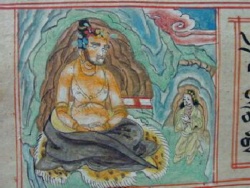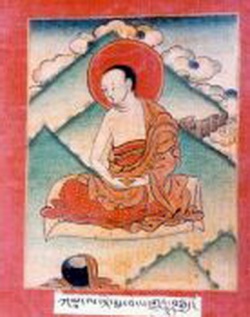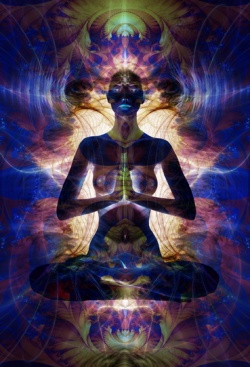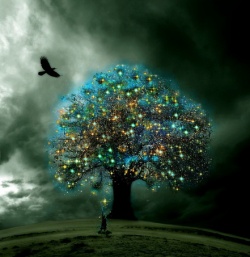Lawapa
Lawapa or Lavapa (Tibetan: la ba pa; grub chen la ba pa; wa ba pa) was a figure in Tibetan Buddhism who flourished in the 10th century. He was also known as Kambala and Kambalapada (Sanskrit: Kaṃbalapāda). Lawapa, was a Mahasiddha, or accomplished yogi, who travelled to Tsari. Lawapa was a progenitor of the Dream yoga sadhana and it was from Lawapa that the Mahasiddha Tilopa received the Dream yoga practice lineage.
Bhattacharya in discussing ancient Bengali Literature proffers that Lawapa composed the Kambalagītika (Tibetan: la ba pa'i glu) and a few songs of realization in the Charyapada.
Simmer-Brown (2001: p. 57) when conveying the ambiguity of ḍākinīs in their 'worldy' and 'Wisdom' guises conveys a detailed narrative that provides the origin of Lawapa's name:
Kambala was a prince of Uddiyana who was ordained as a bhikshu and studied the scriptures. In due course he met a tantric master. Perhaps it was King Dza himself or one of his sons, or maybe Lawapa was one of King Dza's sons. After receiving initiation and instruction he realized pure awareness.
Once when traveling through Uddiyana, he passed through Dhumasthira, the city of the Dakinis, and there he was presented a flower garland by some Shakta-Dakinis. Later, Buddha-Dakinis came to him saying, "Accepting this rosary was a mistake. You must now follow the Shakta path and serve those yoginis who gave you the flowers." Lawapa was undismayed, even when they told him that they had agreed with the Shakta-Dakinis not to interfere in each others affairs, so that they were unable to protect him. In the evening he settled down to meditation and entered his samadhi and at midnight he heard a great noise and saw a shower of boulders thrown by the Shakta-Dakinis descending upon him. The power of his visualized creative phase circle of protection was enough to keep the boulders suspended in the air while his fulfillment meditation shattered the stones into atoms. Today in the space above this acharya's meditation cave in Uddiyana is an unsupported boulder and on the side of the rock which is as smooth as a mirror are many broken rocks and you can actually see these things.
Kambala was also called the Sleeping Bhikshu. He received this name in the following manner. It was his habit to beg alms at the city gate and from time to time King Indrabhuti passed by and would ask him questions, but Lawapa would deign no reply. This infuriated the king who cursed him, "You foolish, ignorant monk!" he said. "It would be better if you just went to sleep!" The Acharya took the king at his word and slept at the city gate for the next twelve years. But whosoever passed him by had to salute him, otherwise they would be frozen rigid. Even the king and his retinue observed this ritual. After twelve years Lawapa awoke and when the king saw him awake he asked him why he had slept. "The king commanded me to sleep," Lawapa replied. The king was filled with faith in the Vajrayana and because of this many people took refuge in the Buddha-dharma.
Kambala is best known as Lawapa, The Blanket, and this is how he received the epithet. He spent much of his time meditating in the cremation grounds of Uddiyana. His power, however, was well known and provided an ineluctable attraction to the local Dakinis. Their leader was a spellbinder called Mantrapada and she was a flesh-eating Dakini and skilled in uttering curses. But she was otherwise known as Sahaja which denotes a realization of the nature of mind in the mahamudra tradition. The Acharya's power seems to have become a negative obsession with Sahaja for she gathered a large number of the Uddiyana yoginis about her, some say as many as five hundred, and went in search of him.
They found his seat but only an empty blanket occupying it. Believing that the blanket contained the power of the Acharya, if indeed it was not his body transformed, they cut it up into small pieces and ate it as if they were making a sacrament whereby they would receive his power and realization. At this point Lawapa appeared in his body, and furious at the loss of his sole blanket cursed them as sheep and the Dakini and her retinue were all transformed into a flock of sheep who scattered at the master's wrath. The sheep went to the Uddiyana king, Indrabhuti, and complained about the Acharya and asked him to redress the wrong done to them. When the king summoned Lawapa before him, the naked Acharya in his turn complained that the Dakinis, had stolen his one possession, a blanket, and demanded that the flock of sheep should be brought before him. The Acharya showed them the mudra of threat and the flock vomitted up the pieces of blanket which were then sewed together. A section was still missing, however, until three of the Queen's attendants came forward and retched up the last three pieces. Again covered with his blanket the Acharya turned the sheep into shaven headed women who vowed to follow the Buddha's path as nuns. Through this means King Indrabhuti was converted and the Acharya gave him empowerment and he achieved siddhi. "Lawa" means blanket, and thereafter the Acharya was known as Lawapa, The Blanket.
Lawapa spent twelve years living in a cave on the Kotambha mountain in Uddiyana. The people of Uddiyana forgot his previous magical deeds and he acquired the reputation of a lazy hermit who slept his life away and who taught that ignorance was enlightenment itself. Meanwhile his disciple, King Indrabhuti, was apparently enjoying a sybaritic life with his five hundred female attendants in a luxurious palace, and, likewise, the people derided him, but as a libertine.
Then once during a feast, when all were present, the king handed a bowl of soup to one of his women and told her to offer it, while it was still warm, to Lawapa, on far distant Kotambha mountain "Close your eyes and say these words," the King told the doubtful girl. '"If the Acharya Lawapa practices the ascesis of sleeplessness may I arrive immediately at his cave."' The girl was immediately whisked away to Lawapa's cave where she found him giving instruction to several disciples and she had to wait until the soup was almost cold. Lawapa then ate the soup leaving some remnants at the bottom of the bowl. "Take this bowl to the King while it is still warm," he ordered. "Say, 'If King Indrabhuti is a brahmacharya, may I reach his palace immediately.'" The girl was returned directly to the King's table and offered him the still warm soup bowl. In this way the people were reminded that both their King and Acharya had power and realization. Later they both taught the people and up to a thousand of them gained the same result.
...worldly ḍākinīs are closely related to the māras of India, who haunted The Buddha under the tree of Awakening. In this role, they took whatever Form might correspond to the vulnerabilities of their target, including beguiling and seductive forms of exquisite Beauty. When that ruse failed, they again became vicious ghouls and demonesses. When the yogin Kambala meditated in an isolated cave at Panaba Cliff, the local mamo ḍākinīs plotted to obstruct his Meditation. Noticing that he was particularly reliant upon a tattered black woolen blanket that also served as his only robe, they asked to borrow it. Sensing the Power of the blanket, they tore it into shreds and devoured it, burning a final scrap in his cooking Fire. In Anger Kambala magically transformed the mamo ḍākinīs into sheep and sheared them, so that when they returned to their original forms their heads were shaven. Fearing the Power of his realization, the mamos vomited up the shreds of blanket, and Kambala collected the pieces and rewove them. From that day, he was called Lvapa, or "master of the blanket".
==Hevajra==
The Hevajra Tantra, a yoginīTantra of the Anuttarayogatantra class, is held to have originated between the late eighth century C.E. (Snellgrove[8]), and the "late ninth or early tenth century" (Davidson), in Eastern India, possibly Bengal. Tāranātha lists Saroruha and Kampala (also known as "Lva-va-pā, "Kambhalī", and "Śrī-prabhada") as its "bringers":
.. the foremost yogi Virūpā meditated on the path of Yamāri and attained Siddhi under the Blessings of Vajravārāhi,...His Disciple Dombi Heruka..understood the essence of the Hevajra Tantra, and composed many śāstras like the Nairātmā-devi-sādhana and the Sahaja-Siddhi. He also conferred abhiṣeka on his own disciples. After this, two ācāryas Lva-va-pā and Saroruha brought the Hevajra Tantra. ... Siddha Sarouha was the first to bring the Hevajra-pitṛ-sādhana
==A teaching story==
In the "Blue Annals (Tibetan: deb ther sngon po): Book 9, The Contemplative Traditions of Kodrakpa and Niguma" it is narrated that Siddha Khyngpo Naljor (khyung po rnal 'byor) went searching for, the sister of Naropa (1016-1100 CE), as she had seen Vajradhara. As Niguma had attained the 'Rainbow body' (Tibetan: jalus) those with a pure Mind might see her Sambhogakaya Form where she had performed Ganachakra in Sosa Island, located in East India. When at Sosa Island, Khyungpo Naljor (Tibetan: grub thob khyung po rnal 'byor) (990-1139 CE) had a dream about Niguma in which he received teachings from her:
He began to Doubt that Niguma was a ḍākinī of the flesh eating class, and while he was Thinking so, she gazed skywards, and then numerous ḍākinīs gathered, and she created a maṇḍala, and bestowed on him the initiation of the illusory Body and the practice of Dreams. After that the Dakini transported him to a distance of about three yojanas, and deposited him on the summit of a mountain of gold. There in a dream, rdo rje btsun mo bestowed on him the Six Doctrines, and then again personally on three occasions the rdorje tshig rkan and the sgyu ma lam rim. Further, she expounded to him numerous Tantras and sādhanas. Niguma said to him: Except myself and Kambalapada no one else knows The Precepts of the Six Doctrines. Till the seventh teacher of the Spiritual Lineage, this teaching should be transmitted down a single line (of teachers). These will be blessed by me, and I shall give them a prophecy.
===Principal teachers===
The Tibetan Buddhism Resource Center (2006) identifies three principal teachers of Lawapa:
- Anangavajra (Sanskrit; Tibetan: yan lag med pa'i rdo rje)
- (Tibetan: Deng ki pa)
- Vajravarahi (Yeshe Tshogyal) (Sanskrit; Tibetan: rdo rje phag mo).
===Principal students===
The Tibetan Buddhism Resource Center (2006) identifies two principal students of Lawapa:
- (Tibetan: nag po spyod pa)
- (Tibetan: indra bhu ti)



